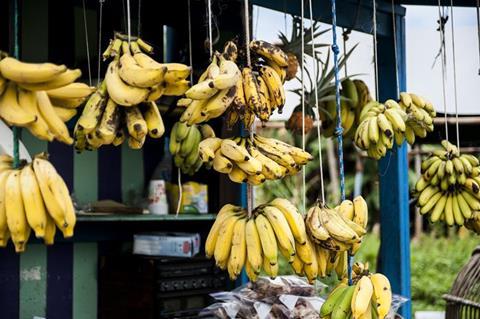Secrets of the trade: Jonathan Hare investigates how to stop his bananas from going off
You may have come across the old trick of putting a banana in a bag with unripe tomatoes to help them ripen more quickly. Have you ever thought about how this works?
Ripening process

Certain fruits such as apples, apricots, tomatoes and bananas are known as climacteric fruits. Climacteric is the name of a stage in the fruit ripening process when cell respiration rises and ethylene gas is produced. This leads to changes in pigment (eg banana skins turning black) and an increase in sugar levels. This stage marks the peak of edible ripeness and from that point the fruit will start to ’go off’.
Ethylene produced by bananas can cause other climacteric fruits (such as oranges and grapes) nearby to ripen more quickly. Even non-climacteric fruits (eg some melons) can still have active ethylene receptors and so may also be affected by nearby fruit, even though they don’t produce ethylene themselves.
Did you know?
Ecuador is the world’s largest exporter of bananas – 5.2 million tonnes every year. The UK imports 1 million tonnes of bananas each year.
Freshness in transit
When fruit is transported in bulk, the air is often monitored for ethylene to check the state of the produce. The ventilation and temperature can then be regulated to try and prolong the freshness of the fruit. Ethylene levels for bananas and avocados need to be kept between 0.1 to 1 ppm. Monitoring at this level is a costly and time consuming process. Recently, a relatively simple nanotube-based ethylene detector has been developed that should make monitoring much cheaper and easier.
When fruit is transported in bulk, the air is often monitored for ethylene to check the state of the produce. The ventilation and temperature can then be regulated to try and prolong the freshness of the fruit. Ethylene levels for bananas and avocados need to be kept between 0.1 to 1 ppm. Monitoring at this level is a costly and time consuming process. Recently, a relatively simple nanotube-based ethylene detector has been developed that should make monitoring much cheaper and easier (http://rsc.li/XsT6Af).
If you could absorb the ethylene produced, would it prolong the life of your fruit? In industry, potassium permanganate is used to achieve this. The complete reaction may be complex, but essentially ethylene is oxidised to ethylene glycol (in some cases it may even be oxidised to CO2):
2KMnO4(s) + 3C2H4(g) + 4H2O(l) → 2MnO2(s) + 3CH2OHCH2OH(aq) + 2KOH(aq)
Stay fresh solutions
When we buy fruit, we obviously want to keep it fresh for a reasonable length of time. It’s a well known fact that mountains of fruit are thrown away before they can be eaten. Suppliers are testing plastic bags impregnated with potassium permanganate. The plan is that customers can wrap fruit up in the bags and it should stay fresher for longer.
A quick web search will reveal all sorts of ‘fruit keeping’ devices, many of which make use of zeolites. Zeolites are a naturally occurring material with many household uses (eg washing powders and cat litter). They consist of an extended microporous crystal structure that readily adsorbs gases and ions. Cartridges containing zeolites soaked in potassium permanganate can be fitted into the base of fruit bowls and storage boxes to keep fruit fresher for longer.
Now that you know some of the science you can make more informed decisions when choosing your ‘fruit keeping’ devices!
Find out more
Learn more about the fascinating structure and properties of zeolites with this website from the British Zeolite Association.
Learn more about the fascinating structure and properties of zeolites with this website from the British Zeolite Association (http://www.bza.org/zeolites/).
Originally published in The Mole









No comments yet